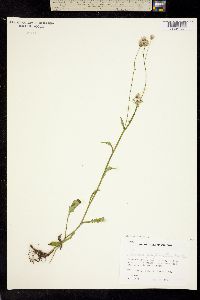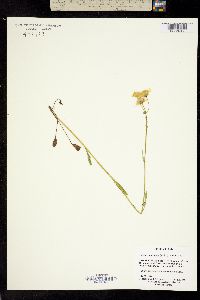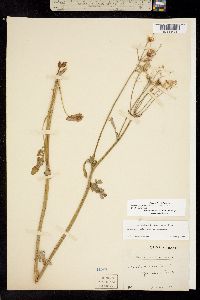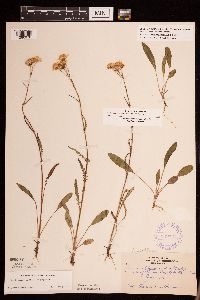Packera paupercula
|
|
|
|
Family: Asteraceae
Balsam Groundsel
[Senecio balsamitae Muhl., moreSenecio balsamitae var. firmifolius Greenm., Senecio crawfordii Britton, Senecio flavovirens , Senecio gaspensis Greenm., Senecio gaspensis var. firmifolius (Greenm.) Fernald, Senecio multnomensis Greenm., Senecio pauperculus Michx., Senecio pauperculus var. balsamitae Fernald, Senecio pauperculus var. crawfordii , Senecio pauperculus var. firmifolius Greenm., Senecio pauperculus var. flavovirens (Rydb.) B. Boivin, Senecio pauperculus var. neoscoticus Fernald, Senecio pauperculus var. praelongus House, Senecio pauperculus var. thompsoniensis , Senecio pauperculus var. thomsoniensis (Greenm.) B. Boivin, Senecio tweedyi Rydb.] |
Perennials, 20-45+ cm; subrhizomatous (bases weakly branched, ascending to erect). Stems 1 or 2-4, loosely clustered, glabrous or sparsely tomentose proximally. Basal leaves petiolate; blades lanceolate to narrowly elliptic or oblanceolate, 30-60+ × 10-20+ mm, bases tapering, sometimes obtuse, margins subentire to dentate or serrate. Cauline leaves gradually reduced (proximals petiolate, sublyrate; mids sessile, not clasping, lanceolate, dissected, incised, or lacerate; distals sessile, bractlike). Heads 2-10+ in loose or compact, corymbiform arrays. Peduncles usually bracteate, sometimes ebracteate, glabrous. Calyculi inconspicuous. Phyllaries 13 or 21, green, 5-8+ mm, glabrous. Ray florets 0, 8, or 13; corolla laminae (pale yellow) 5-10+ mm. Disc florets 50-65+; corolla tubes 2-3 mm, limbs 2-3 mm. Cypselae 1-2 mm, usually glabrous, sometimes hispidulous on ribs; pappi 3.5-4.5 mm. 2n = 44, 46, 92. Flowering May-late Jun (south), late Jun-early Aug (north). Wet meadows, open woodlands, along streams, rocky outcrops; 0-3000 m; Alta., B.C., Man., N.B., Nfld. and Labr., N.W.T., N.S., Nunavut, Ont., P.E.I., Que., Sask., Yukon; Ala., Alaska, Colo., D.C., Ga., Idaho, Ill., Ind., Iowa, Ky., Maine, Md., Mass., Mich., Minn., Mont., N.H., N.J., N.Y., N.C., N.Dak., Ohio, Pa., S.Dak., Tenn., Utah, Vt., Wash., W.Va., Wis., Wyo. Ecologically and morphologically, Packera paupercula is the most variable species of the genus in North America. Some 'phases' have been treated as separate species, subspecies, varieties, forms, and races. Variation within P. paupercula hints at some interesting evolutionary relationships; characteristics used to separate taxa overlap. Much of the morphologic variation in this species may be due to hybridization and introgression. I do not recognize any of the infraspecific taxa that have been proposed.
Perennial 1-5 dm from a rather short caudex, occasionally also with very short slender stolons or superficial rhizomes, lightly floccose-tomentose when young, generally soon glabrate, except often at the very base and in the axils; basal lvs mostly oblanceolate to elliptic, generally tapering to the petiolar base, crenate or serrate to subentire, seldom over 12 נ2 cm; cauline lvs ±pinnatifid, the lower sometimes much larger than the basal, the others conspicuously reduced and becoming sessile; heads seldom more than 20; disk 5-12 mm wide; invol 4-7 mm, its bracts often purple-tipped; rays 5-10 mm (rarely wanting); achenes glabrous or hispidulous; 2n=40-92, often 44 or 46. Meadows, moist prairies, streambanks, beaches and cliffs; Lab. to Alaska, s. to Ga. and Oreg., more common northward. May-July. (S. balsamitae) Gleason, Henry A. & Cronquist, Arthur J. 1991. Manual of vascular plants of northeastern United States and adjacent Canada. lxxv + 910 pp. ©The New York Botanical Garden. All rights reserved. Used by permission. From Flora of Indiana (1940) by Charles C. Deam This plant prefers moist, mucky or sandy soil and is usually found in fallow fields where it sometimes covers acres (near Griffith, Lake County). Less frequent in prairie habitats along roadsides and in open flats in woods. Local in its distribution. Reported also from St. Joseph and Wabash Counties. …… Indiana Coefficient of Conservatism: C = 3 Wetland Indicator Status: FAC |
|
|
|































































































